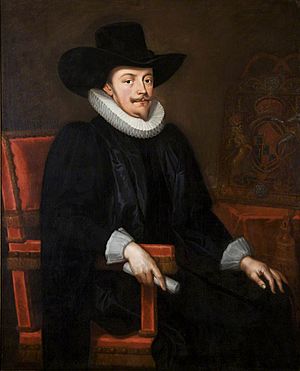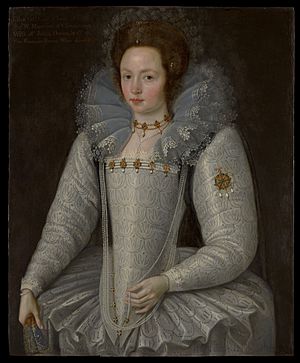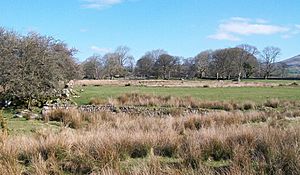John Owen (Royalist) facts for kids
Quick facts for kids
Sir
John Owen
|
|
|---|---|

Portrait of Sir John Owen, c.1660
|
|
| Vice-admiral of North Wales | |
| In office 1660–1666 |
|
| Sheriff of Merionethshire | |
| In office April 1632 – March 1633 |
|
| Sheriff of Caernarvonshire | |
| In office April 1631 – March 1632 |
|
| Royalist Governor of Conwy | |
| In office December 1644 – November 1645 |
|
| Personal details | |
| Born | 1600 Clenennau, Dolbenmaen, Caernarfonshire |
| Died | 1666 Clenennau |
| Resting place | St Beuno's Church, Penmorfa |
| Nationality | Welsh |
| Spouse | Janet Vaughan |
| Children | One son, two daughters |
| Military service | |
| Allegiance | Royalist |
| Rank | Colonel |
| Battles/wars | |
Sir John Owen (1600–1666) was a Welsh landowner from Anglesey. He was a brave soldier who fought for the King's side, known as the Royalists, during the Wars of the Three Kingdoms. He led many troops in North Wales.
People had different opinions about Sir John. The Earl of Clarendon, a historian, said Owen was "a plain gentleman of Wales, who had been always taught to obey the King." However, Oliver Cromwell, a leader of the Parliamentarian side, called him "a violent man." After a major conflict, Sir John was sentenced to death in 1649 for going against the government and for causing the death of a Parliamentarian official. But he was later saved from this punishment. When the King returned to power in 1660, Sir John became the Vice-Admiral of North Wales. He passed away in 1666.
Contents
Early Life and Family
John Owen was born around 1600 in Eifionydd, a region in northwest Wales. He was the oldest son of John Owen of Bodsilin, Anglesey. His mother, Elin Maurice, came from an important family in Clenennau. When his father died, his mother remarried Sir Francis Eure.
John Owen's family had strong ties to the Church of England and believed in the King's divine right to rule. This loyalty to the King and the church was very important during the Civil War. After serving in the military, John inherited the large Clenennau estates when his mother died in 1626. He also held important local roles, serving as High Sheriff for Caernarfonshire in 1630 and for Merioneth in 1631.
Fighting in the First Civil War
When the First English Civil War began, Sir John Owen was asked to help raise an army for King Charles I. He was given money to gather soldiers in the three areas of Gwynedd. However, it took some time to get the troops ready because of local disagreements.
Owen and his soldiers first served near Oxford. Then, they joined Prince Rupert's army during the attack on Bristol, where Sir John was injured in the face. He later became the Governor of Reading and fought in the First Battle of Newbury in September 1643.

By 1644, Sir John was back in Wales. He was again made Sheriff of Caernarfonshire. After an attack on Wales by Thomas Myddleton, King Charles knighted Owen and made him Governor of the important walled town of Conwy. In February 1645, he became a senior officer under the Governor of Chester, John Byron, 1st Baron Byron.
Sir John faced many challenges as governor of Conwy. The town's defenses had been set up by Archbishop Williams of York, who was from Conwy. In May 1645, Owen took control of Conwy Castle from Williams by force. King Charles himself was unhappy about this. Their relationship worsened when Owen took supplies from Williams' family. As the King's control in Wales weakened, Williams helped Parliamentarian troops take Conwy in August 1646. Owen held onto the castle until November 9, when he finally surrendered under fair conditions. After the war, he returned home and was fined by Parliament. He turned down an offer to lead Welsh soldiers in France.
The Second Civil War

By 1648, it seemed peace was unlikely. King Charles made a deal with a Scottish group to invade England and bring him back to power. Also, some Parliamentarian soldiers were unhappy about not being paid. An uprising started in South Wales in March 1648. Sir John Owen decided to join this rebellion in Caernarfonshire.
In early May, Owen began gathering former Royalist officers. His old commander, Byron, also arrived from France. Sir John managed to avoid Parliamentarian forces and by early June, he had about 300 men. On June 3, he attacked Caernarfon, capturing the High Sheriff, William Lloyd. Lloyd was badly hurt and later died while being held by Owen's men.
Owen then heard that another Parliamentarian force was coming. He decided to meet them in battle. On June 5, he fought at Battle of Y Dalar Hir near the Menai Straits. The battle was confusing, and at first, Owen seemed to be winning. But a Parliamentarian soldier, Captain Edward Taylor, fought Owen one-on-one, pulled him from his horse, and captured him. The remaining Royalist soldiers then scattered.
Owen was taken to Denbigh Castle. His officers tried to rescue him several times, but failed. He was later moved to London and held at Windsor Castle.
Trial and Later Life
Sir John Owen was accused of going against the government, breaking his surrender terms from 1646, and causing the death of William Lloyd. He was tried in February 1649 alongside other important lords who had also led rebellions. He was sentenced to death. It is said he joked that it was "a very great honour to a poor gentleman of Wales to lose his head with such noble lords."
However, Owen asked for his sentence to be changed, and he was saved from execution. The exact reason is unclear, but some believed Oliver Cromwell or other important figures helped him. By July, he was free in London and by September, he was back at Clenennau.
During the 1650s, Owen lived quietly at home, though his movements were watched. In 1659, he joined another Royalist uprising, which led to his property being taken away temporarily. After King Charles II returned to the throne in 1660, Sir John was rewarded for his loyalty. He was made Vice-Admiral for North Wales. However, he was more of a soldier than a politician and did not take much part in public life after that. He died in 1666 and was buried at Penmorfa Church.
Family Life
Sir John Owen married Janet, the daughter of Griffith Vaughan. They had one son, William (1624–1677), and two daughters, Anne and Katherine. Through William, Sir John was an ancestor of the Owen and Ormsby-Gore families. Katherine became known for supporting Welsh writers and poets.
The Owen family, over many years, supported Welsh language poets. The National Library of Wales has old writings from the Brogyntyn collection that include poems praising Sir John Owen. These include poems written when he became Sheriff and a long poem celebrating him.



